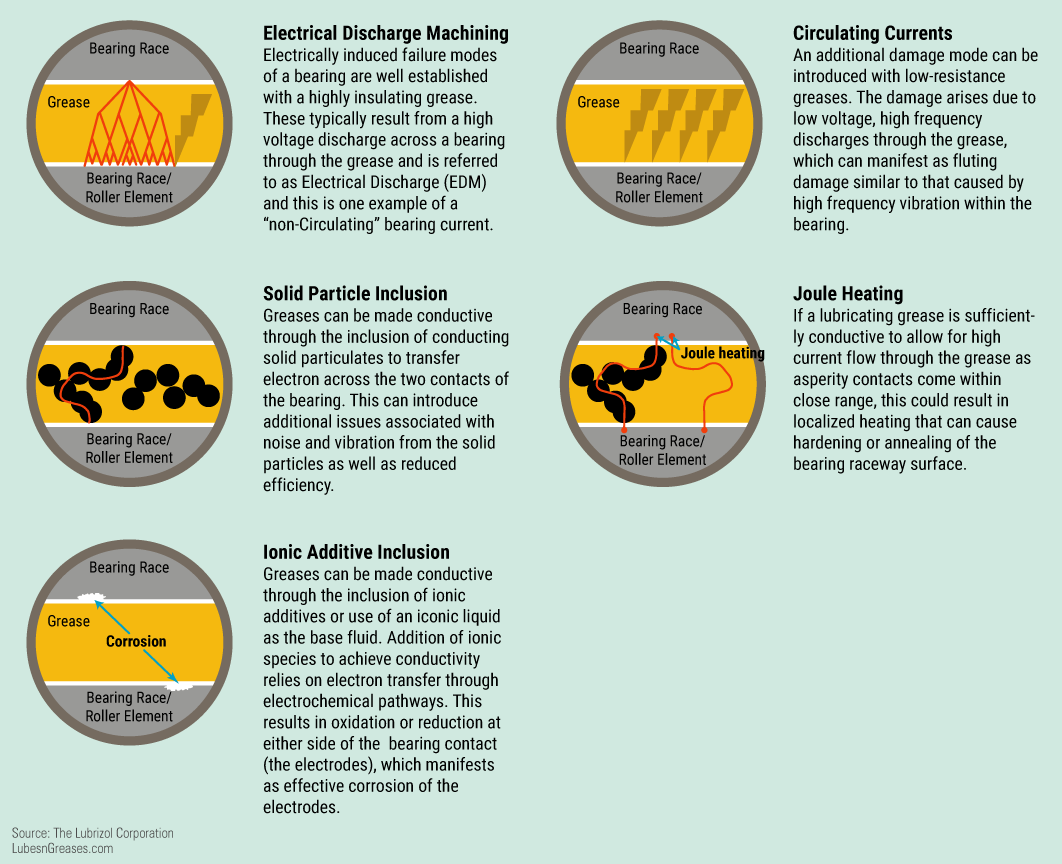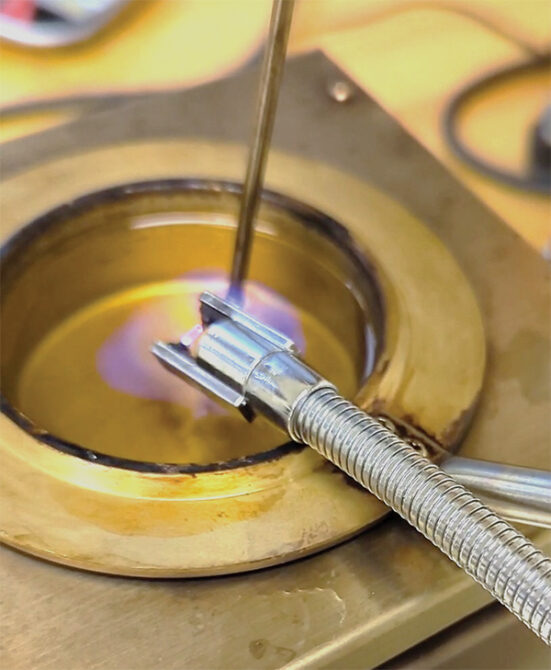
The grease industry has a stellar track record of developing products for vehicles. As government mandates will limit future sales of conventional passenger cars and light trucks with only gasoline-powered internal combustion engines, vehicle OEMs are rapidly developing next-generation battery-powered electric vehicles. This transition offers challenges and opportunities for grease formulators and suppliers in the dynamic and fragmented EV market.
BEVs rely on batteries that gradually discharge while driving and must be tethered to a recharging station to be replenished. Expectations for longer driving range in tandem with specialized operating conditions are creating new demands for greasing BEVs.
“Thus far, greases and other lubricants used in ICE vehicles have largely been repurposed for use in BEVs. This has worked to a degree, but it has led to less-than-optimal efficiency, drive distances and part lifetimes,” Jacob Scherger of Functional Products Inc. told Lubes’n’Greases.
Gareth Fish of The Lubrizol Corporation agreed: “In the future, more than 90% of greases on an EV will be the same as those used on current ICE and HEVs. However, it will be necessary to update greases used in the sideshafts and in wheel bearings for higher efficiency and better load-carrying capacity.
“Additionally, OVMs will need new lubricants for windscreen/windshield wiper motors (for better efficiency), and coolant motor and pump greases (for compatibility with new coolants and efficiency). Some vehicles will need new, higher-performance e-motor bearing greases, whilst others will be oil lubricated. Certain greases—including those for front-end accessory drive bearings, drive shafts and starter motors—will become obsolete.”
What does all this mean for grease specifications in the future? “Many bearing manufacturers have specifications for BEV transmission motor greases used in “dry” motors,” Fish said. “However, the automotive industry is already migrating to ‘wet’ motors to achieve better cooling. Bearings in wet motors are lubricated with transmission fluid instead of grease. The new specifications for EV transmission motor greases will become obsolete.”
Peter Lee of Southwest Research Institute explained that certain aspects of grease performance are specific to the unique operating environment of EVs. “The lack of noise allows vehicle occupants to hear the Noise Vibration Hardness and Buzzing, Squeaking and Rattling always present in vehicles,” he said. “The noise from shaft and wheel bearings are more noticeable than in ICE vehicles, and greases need to play their part in reducing this noise. In addition, dashboard and other cabin noises are more obvious. Besides being an annoyance to occupants, they suggest lack of build quality. There will be an increased need for lubricants, including greases, to reduce these noises.”
Specifications
Experts agree that new greases will be needed for EVs, and electrification amounts to a paradigm shift that is rapidly trickling down to the grease industry.
According to Fish, there are no pending regulatory requirements for EV greases. However, testing under the REACH and data reviews by the European Chemicals Agency have identified issues with common lubricant components that will need to be replaced or relabeled. UK REACH now classifies lithium hydroxide, which is used to manufacture simple and complex lithium thickeners for greases, as a Reproductive Toxin Category 1A, and ECHA may do likewise.
Lee noted that some grease manufacturers are moving away from lithium because of the potential for lithium price increases and a general move toward more environmentally conscious ingredients. Lithium 12-hydroxystearate is being replaced by polymeric thickeners, as they are better at sound reduction.
“Different grease manufacturers are working on optimizing greases for BEVs. Some work directly with OEMs to figure out what specifically needs to change so that their products meet the needs of BEVs,” Scherger said. “One of the biggest challenges is that there is no general consensus on specifications or specific performance targets. Engineers and formulators discuss new operating conditions in broad terms, but not the details of what is needed or the use of readily available bench tests to allow for quick optimization of greases.”
OVMs have not reached a consensus for grease specifications for EVs. Fish commented that a few specifications for a key issue, grease conductivity, have been reviewed, but they are inconsistent. One specification called for greases to be conductive, while another called for greases to be static dissipative with volume resistivity requirements differing by more than 10 orders of magnitude.
While OEMs are developing next-generation BEVs, they have provided no details of their proposed grease specifications in the public domain. “The market is too competitive at the moment, and each EV OEM is struggling to be the market hegemon. Grease is given the status of proprietary technology. However, I expect that as the EV market matures, an era of cooperation will follow, and general specifications will be established,” said Paul Bessette of Triboscience & Engineering, Inc.
“In general, it is the component manufacturers that have specifications for parts such as shaft bearings or wheel bearings,” Lee said. “Such specifications include speed and load-carrying capabilities, antioxidant and seal compatibility. There is also a need for greases to not include additives that can be potentially damaging to the coatings on the copper windings of motors.”
Fish noted that various trade magazines, popular magazines for automobile enthusiasts and online chat rooms have published claims about new OVM targets for motor speeds in the 10,000-18,200 rpm range that are significantly faster than those of ICEs. He explained that higher motor speeds are expected to increase e-motor efficiency. However, there may be associated issues with vibration, lubrication and gearboxes.
Revolutions per minute speaks to the number of times that the crankshaft spins per minute, which corresponds to the operating speed of the engine. Power output increases with increasing rpm up to the so-called redline, then decreases. For example, ICEs can output 200-300 horsepower at 6,600 rpm in Toyota Camrys and up to 490 hp at 4,500 rpm in a Corvette Stingray.
Scherger noted that the high rpm and instantaneous torque in BEVs are new challenges for grease formulators. “To truly optimize grease for BEVs, it will be necessary for formulators to consider shear thinning and shear stability more carefully than in current automotive greases. The target range has yet to be decided.”
The new NLGI HPM grease core specification and additional performance tags do not cover high-speed applications. The highest current standardized test, the ASTM D3336 grease life “Pope” Test, utilizes bearings with a DN factor of 355,000 at 10,000 rpm. The DN factor is the product of the mean diameter and rotational speed of a bearing. Fish reported that bearing makers are developing bearings for high-speed applications in e-motors; their specifications are proprietary.
E-motors
“There are upwards of 80 electric motors on a BEV, and all these electric motors consume energy and hence reduce vehicle range,” Lee told Lubes’n’Greases. “Reducing torque has become more important, and greases need to be more energy efficient. This is achieved by selecting grease to protect the surfaces from wear with the thinnest film practical to prevent churning losses due to drag on the bearing as it turns. This includes careful selection of the base oil—almost always a synthetic—and can be aided by more energy-efficient thickener structures.”
He continued: “BEVs are heavier than conventional vehicles due to battery mass, meaning the greases in the wheel bearings have to tolerate higher loads and temperatures. There is a trade-off between lighter oils with lower viscosity and better energy efficiency at higher speeds, and heavier oils with greater load bearing capacity that form thicker lubricating films and provide better protection from wear. When temperatures are higher, there is a greater need for antioxidants.”
Benchtop testing methods that accurately relate to BEV conditions are needed to help solve some of these problems. According to Scherger, current laboratory test methods are often performed at speeds or temperatures that are too low and/or ignore electrification effects. Standardizing test methods relevant to EV operating conditions will hopefully lead to specifications and enable formulators to optimize greases for BEVs.

What else do BEVs demand from greases? “BEV powertrains need to be compact and efficient and have high power density,” Lee said. “This requires the grease to perform at high speeds and high temperatures without oxidizing or shear thinning excessively. They also need to have the right bleed and lubricity performance.”
Fish added that the lack of a catalytic convertor should reduce the upper temperature for inboard constant velocity joint greases of BEVs. The CVJ will need to support higher torques at lower speeds for e-motors than ICEs.
Fish agreed: “There is currently no easy way to measure efficiency of very small bearings. Rheological testing for grease flow characteristics and friction measurements can give clues, but the differences in performance between small bearings are similar to the uncertainty of torque measurements. It is especially important to accurately measure performance when grease is in a softened state similar to after it has been worked in a bearing.”
Grease Conductivity
Bessette predicted that “perhaps the greatest tribological challenge will be the development of electrically conductive greases for rolling element bearings.”
Where do greases currently stand in relation to this need? “Many greases currently used in BEVs were developed to be insulators,” Scherger said. “But in BEVs, static charges can build up on metal surfaces separated by grease, such as the inner and outer rings of a ball bearing. Static discharge can cause micropitting, which reduces the lifetime of parts. This is not a simple case where more conductivity is better. The correct range for grease conductivity in BEVs is still largely unknown.”
Fortunately, this issue is being addressed. “One OVM has switched to using hybrid bearings with rolling elements made of ceramic instead of steel to prevent damage from electrical discharge,” Fish said. “This solution is costly, but it is very effective, and hybrid bearings have better durability than all-metal bearings. Another OVM has added a sacrificial component that collects discharged sparks; it must be replaced when the vehicle is serviced.”
Volume Resistivity

If conductivity is too high, it may cause short circuits or current leakage, Lee cautioned. If conductivity is too low, it can cause a net charge buildup, resulting in electrically induced bearing damage. In principle, it’s possible to formulate greases with conducting solids, like graphite or metal particles, to “tune” their ability to store and dissipate electrical charge.
Fish and his colleagues developed test methods to explore the effects of grease composition on conductivity. They applied high voltages to grease films sandwiched between two flat stainless steel disk electrodes and measured current with sub pico-amp sensitivity. They reported the volume resistivity, ρ.
For simple lithium, lithium complex and polyurea NLGI 2 base greases, ρ was 1013-1016 (insulating). Several additives successfully reduced ρ for the polyurea grease to 1010 – 1012 (static dissipative). They applied their test to evaluate greases in loaded running thrust bearings and correlated ρ with temperature and microscopic images of bearing damage. Their results revealed phenomena associated with static discharge and determined that greases with ρ in the range of static dissipators were very effective.
Flammability
Paul Shiller of First Power Group, LLC told Lubes’n’Greases that the voltages used in BEVs are high enough to cause arcs across gaps along the electrical distribution cables. A hot enough or long enough discharge near greased parts could cause a flammability issue. Even partial discharges through hydrocarbons can produce hydrogen, methane, acetylene and other flammable or explosive gases, which is a possible cause of transformer explosions.

In this open cup flash point test, oil that has vaporized in the test flashes approximately 10°C lower using an electric arc discharge than by using a flame. Photo courtesy of Bao Phan, First Power Group, LLC.
He reported flash points that were lower under an arc than under a flame in the Cleveland Open Cup test. The choice of base oil, additives and high vapor pressure compounds could increase risks for grease flammability and accidents, especially if improper greases or cleaners are used for EVs.
Mary Moon, Ph.D., has experience formulating, testing and manufacturing lubricating oils and greases and polymers. She has served as Chair of the Philadelphia Section of STLE and Technical Editor of The NLGI Spokesman and received the Clarence E. Earle Memorial Award (2018) and the Golden Grease Gun Award (2022) from NLGI. She is currently working as a professional writer and editor. Contact her at mmmoon@ix.netcom.com